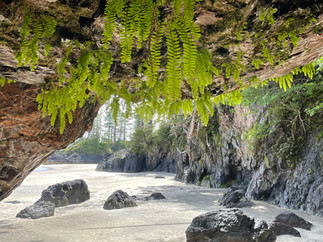PART 5 - PADDLING WITH FRIENDS -Jun. 25th - Day 27 - St Josef Bay
- Felipe Behrens
- Apr 12, 2023
- 5 min read
Updated: Feb 4, 2024

St Josef Bay must be the most beautiful beach in all of Vancouver Island. The bay is nestled deep inside a cut on the cliff walls that roll down from Cape Scott and is surrounded by old growth forest whose trees reminded me of the columns supporting the ceiling of a great temple. The low tide exposed a beach a thousand feet wide covered by a sand canvased into a never-ending myriad of colorful patterns by the receding water. Even the most skilled abstract painter would find it hard to match the detail.
After setting camp and notifying JF that I had made it to our rendezvous point with a day to spare, I went on a walk to explore the coastal landscape. At high tide there are many sea stacks that are inaccessible, but when the tide recedes, they become connected to the mainland, and it is possible to walk between the rocks and discover what the sea water has sculpted.
I was fascinated by how the creatures of the tide pools predictively layer themselves in a precise hierarchy. At the very bottom where the rocks are wetted even at low tide are the mollusks and starfish. Then come the shellfish which always have the larger individuals in the bottom and smaller ones on the top, as those on the lower down have more time to feed in the water. After them come the barnacles which can survive exposed to the air the longest. The final layer before where the rock is permanently exposed in all but the highest tides is capped by a scrawny little algae called the rockweed which is the kayaker’s most feared plant. If you paddle over rockweed, then you’re about to hit the bottom of your boat. You never want to gamble paddling your kayak over a bed of rockweeds.
While meandering my way through the sea stacks I found a deep cave gouged into the rock cliff ringing the beach. The cave was deep enough that my eyes needed a moment to adjust to the low light, and when I turned to stare at the entrance the landscape outside was a white glare. The cave roof was covered with a thin moss layer and dripped constantly as though it had started to rain. The water was fresh, which meant it must be percolating through the rock above where the trees are growing. At the deepest point in the cave was an interesting artifact from the sea; a large piece of driftwood which proved that when a storm is raging in the Pacific Ocean, this cave will be no safe to hide.
I think that the cave is the preamble to a new sea stack in the making. As the sea gouges ever deeper into the cave, eventually the roof won’t support itself, and whatever remains after the collapse will become a new sea stack. Rocks last a long time, but not forever. Ultimately even the sea stacks will topple one day, and the mollusks and barnacles will finish off whatever is left of the rock. Walking from the treeline down the cliff and ending at the water’s edge is a cross-sectional journey through time.
Please Consider Buying an Item to Help me Keep the Site Funded
In the afternoon I decided to hike part of the Cape Scott Trail inland as I was told by a fellow camper mentioned to me that on the trail was an immense spruce tree.
“It’s definitely worth the walk, it’s about a mile beyond Eric Lake on the way to Nels Beach.”
I put on my boots, grabbed my wide brim hat, holstered the bear spray on my shorts, and fitted two Perrier bottles to the back pockets on my shirt.
The walk wasn’t very eventful and there wasn’t much to see. The trail is buried in the forest, there are no viewpoints, and the canopy is thick with only a few shafts of light landing on the forest floor. As the distance from the sea increased the moderating effect of the ocean on the temperature became less pronounced, and the humidity made it feel like spring day in Florida.
At Eric Lake I found a pebbled beach where I could see that the sky was bright and sunny. I stretched my neck to look as far down the trail as I could, and when I was reasonably sure there wasn’t anyone nearby, took a skinny dip into the refreshingly cool water.
Passing the lake I was on the lookout for the big spruce tree. “It can’t be much further.” I thought.
The trail began a steep climb up a mountain in a series of switchbacks. I eventually caught up with a couple on their way to hiking the entire Cape Scott Trail.
“Oh, we passed it a while ago.” They said, to my chagrin.
I turned around and began walking back but soon arrived at the lake without finding the tree. I concluded I must have had too high expectations after seeing the big Cedar on Hansen Island. I saw several large spruce trees on the trail but none whose height and girth spoke to say, “Yes, I’m the big tree everyone writes home about.” I must have passed the tree and failed to be impressed enough to notice it.
At the parking lot where the trail forks between the way to Cape Scott and St Josef Bay I ran into three college aged girls piling their camping gear onto the trail wheelbarrow provided by the park service for those making their way to the campsites on the beach.
“Well, those fancy Hawaiian shorts sure go with this wheelbarrow.” One of them said, while pointing at my colorful attire.
“I suppose if they fit you, then I can give them to you.” I said, deliberately pretending to misunderstand her. They laughed and she gave the obvious clarification.
“We are asking if you would be a gentleman and push it for us.”
“You mean the two miles to the beach camp?”
“Yes.”
I thought about it for a moment on how I could diplomatically decline the request.
“Sorry. But I have to go take a massive dump. Seriously, it cannot wait.” I said, noting their surprised shock at my blunt response.
That was, however, a half-truth. I had to go, but not so urgently that I couldn’t handle the discomfort of pushing a wheelbarrow all the way to the beach. The part I didn’t say out loud was that I didn’t think any of them were cute enough to be worth pushing a wheelbarrow full of camping gear for two miles.
St Josef Bay














































Comments